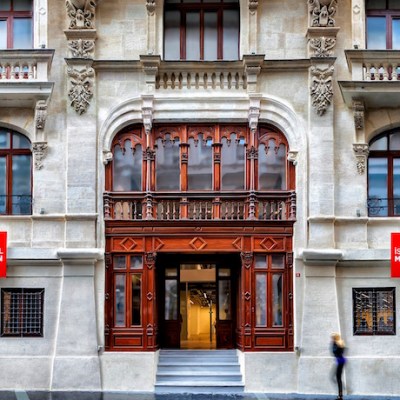When Ara Güler, for many the greatest photographer of modern Turkey, died last month at the age of 90, the city he devoted his life to photographing came to a standstill. Thousands of admirers, young and old, gathered to pay respects before the funeral service of a man historians and fellow photographers have called the memory, or the eye, of Istanbul. As Güler’s coffin was placed on a podium in Galatasaray Square, a black-and-white photograph he took in the 1950s appeared in the background, capturing fishing boats sailing on the Bosphorus at early dawn.
Kumkapi fishermen returning to port in the first light of dawn, Istanbul, 1950, Ara Güler. Courtesy Ara Güler Museum

Güler was born in Istanbul in 1928, to Armenian parents who had remained in Turkey despite the deportations and massacres under the Ottomans in the early 20th century. Güler’s father spent much of the 1940s in hiding to survive nationalist attacks on minorities, and to escape a punitive government tax levied on Armenians. From his father, however, who as a chemist developed Turkish film stock and became familiar with figures from that industry, Güler inherited a cheerful legacy: his father’s friendships with actors and artists inspired Güler initially to become a scriptwriter, before ultimately finding his true calling in photography. Having had some of his photographs of Istanbul’s fishermen published in the Turkish-Armenian newspaper Jamanak in 1952, he went on to work for Turkey’s high-circulation weekly magazine Hayat, and, when the US company opened an office in Istanbul, for Time-Life. Commissions from the likes of Paris Match and the Sunday Times followed; a meeting with Henri Cartier-Bresson in Paris resulted in Güler joining Magnum’s roster in 1953, and he was soon photographing the likes of James Baldwin, Alfred Hitchcock, Salvador Dalí and Winston Churchill.
Zeyrek, Ottoman graves, Istanbul (1957), Ara Güler. Courtesy Ara Güler Museum

Down-to-earth and hard-working, Güler considered himself a visual historian rather than an artist. Like Dziga Vertov’s Man with a Movie Camera (1929), which filmed life in Soviet cities over several years, he obsessively recorded the Istanbul of the 1960s and ’70s, immortalising such scenes as a train enveloped in steam, a dozen forgotten tombstones etched with Ottoman script, a dreamy bridge on the Golden Horn linking Istanbul’s financial and historic quarters, trams in snow, a Sufi lodge lively with flute players and whirling dervishes, the interiors of a smoky wine-house, or a serene mosque.
Galata Bridge, Istanbul (1956), Ara Güler. Courtesy Ara Güler Museum

Güler was often drawn to the ancient silhouettes of Ottoman monuments or dust-covered objects from the previous century. Determinedly old-fashioned, he showed little interest in modernist architecture. He didn’t like Ankara, the republic’s cold capital. Istanbul’s graveyards, hulks, ruins and shabby streets were more to his taste. In the 1980s, as Istanbul began to resemble a second-class Western city, he stopped photographing it as he had done before.
Sehzadebasi, Istanbul (1958), Ara Güler. Courtesy Ara Güler Museum

In the 1990s, growing interest in urban history in turn rekindled interest in Güler’s work. Books illustrated with his photography – Living in Turkey (1992), Sinan: Architect of Süleyman the Magnificent and the Ottoman Golden Age (1992) and Ara Güler’s Istanbul (2009) – passed hand to hand among liberals and Islamists alike. For me, the grainy Istanbul that emerged from the shabby music halls, tiny churches and adventure-courting ships in Güler’s images has always held a near-magical appeal. His Istanbul urged the viewer to set out and see whether it existed still; the city’s ruthless modernisation sends one back to his photographs with even more nostalgia.
Beyoglu fish market, Istanbul (1954), Ara Güler. Courtesy Ara Güler Museum

A canonised figure, Güler spent his last years entertaining fans and young photographers at Kafe Ara (run by one of his assistants) in Galatasaray and planning an Ara Güler Museum. It opened on his 90th birthday, two months before his death; a tastefully curated selection of Güler’s photography equipment and work (he made some 80,000 images in all), it will soon expand to incorporate his apartment-turned-archive in Galatasaray. Today, as an unassailable programme of construction transforms Istanbul into a city its locals struggle to recognise, its storied bridges, alleyways, docks and narrow backstreets retain their liveliness and beloved character in Güler’s pictures.



